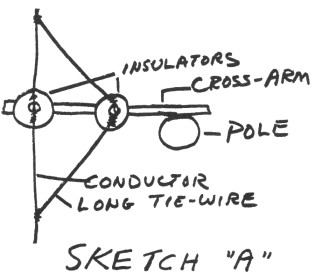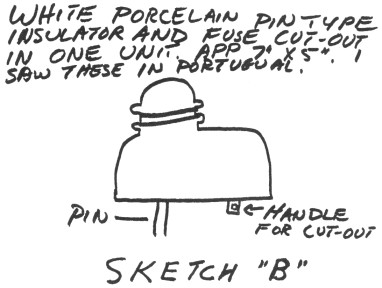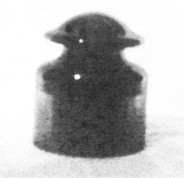Foreign Insulators
by Marilyn Albers
Reprinted from "INSULATORS - Crown Jewels of the Wire", April 1981, page 9
To Spain Again
I'm waving at Jack Tod, just a few pages away in
his "Porcelain Insulator News" column. He sent me the material for
this month's article on Spain, based on some correspondence he had from Bill
Ogden (Virginia, Minnesota). Since Bill had also called me at about the same
time reporting on Spanish and Portuguese insulator finds, I just put it all
together for you. I would like to include here Bill's sketches and the letter he
wrote to Jack.
|
November 4, 1980
Dear Jack,
Thanks very much for answering my
questions from last summer. In August I was on a two-week's guided tour of Spain
and Portugal. For an insulator collector, this was certainly a treat. I've never
seen so many open-wire communication lines before.
The Portuguese for their
phone lines, use a steel angle-iron crossarm with one-half inch steel pins and
white porcelain insulators most generally. The larger ones resemble those
sketched in Mrs. Alber's article in the October '80 Crown Jewels. These are
approximately 3"x4-1/2", with the single wire groove. I also noticed
five or six styles of white porcelain ponies and some glass in near-clear and a
few examples in blue. This glass could be the CD 130.6 or 130.7.
The Spanish
phone lines look very much like the ones still found in America. Unlike the
Portuguese, they use wood cross arms with the one inch pin, and even the
"H" and "phantom" types of transposition brackets. By far
the most common type of insulator is the glass CD 154. There are comparatively
few CD 106's, and two types of porcelain. The glass are E.S.A.//C.T.N.E. (Esperenza
Glass Factory//National Telephone Company of Spain), for a rough translation.
I'm told some Hemingray 42's are found! The more common of the porcelain is
shaped like the CD 154. It somewhat resembles the U177. I saw hundreds of these;
most were various shades of brown, with a few mottled tans. I've talked with
several collectors who have or have seen these, but no one knows the story
behind them. These seem to be unembossed. This is not a European style of
insulator; could these have been made in America and exported to Spain? If so,
who made them?
The other Spanish porcelain communications insulator was somewhat
like the glass CD 128, except for a higher and more rounded dome. Most were
white; I saw a very few blue and green ones. For some reason, these were not on
the cross arms, but on metal side brackets on the pole.
I noticed
numerous interesting features on the power lines. One is the practice of tying
the conductor wire to two side-by-side insulators; see sketch "A". I
saw several white glazed fuse cut-out and pin type insulators in the same unit;
see sketch "B". Two or three poles had brown "pork-liver"
strain insulators. Wonder if these were O-B's? Both countries use large pin
type, cemented three-piece glass insulators, which seemed to be about the size
of the largest Pyrex. I saw these in near- clear and aqua; I thought the aqua
was especially pretty in the sunlight! The construction of the high voltage
lines seems to be very much like what one sees in the states. The suspension
discs were either clear, near-clear, or aqua glass or brown and white porcelain.
I don't recall seeing white suspension discs in America. Sky glaze does not seem
to be used. All considered, a very interesting trip.
Yours truly,
William C.
Ogden
N.I.A. #1857

- - - - - - - - - - -

|
In a subsequent letter to me Bill added: "I saw
the E.S.A. CD 154's in the following colors: clear, near clear, light "coke
bottle" green, medium blue, dark blue, dark blue green and dark green. Are
there any other colors I didn't mention?" Bill, I believe that about covers
it! Mel Harder (Virginia Beach, Virginia) lived in Spain for several years and
did not report any other colors besides those.
In regard to Bill's question
about finding Hemingray 42's and porcelains of a similar design (like U-177),
Jack's answer was: "I don't know an answer to your question about the
common items similar to CD 154/U-177 maybe being made in the U.S. or England and
being imported to Spain. If they were pre 1930 items, maybe possible. If modern
times, not likely from U.S." Wild guesses on foreign items cause short
circuits in Jack's crystal ball (We should all be so wise!), but he was
impressed with the porcelain insulator Bill reported seeing that was a
combination of a pin type and fuse cut out (Sketch B). I am, too! Any input on
this one? Incidentally, Bill, I believe the glass insulator you reported seeing
in Portugal had to be a CD 130.6 rather than 130.7. Gene Calman (San Diego,
California) has a CD 130.6 in his collection that he brought back from Portugal.
It is a near clear color (?).
Referring you back now to Crown Jewels article on
Spain (May 1980), Mel Harder says that "in talking to some old timers from
the Spanish phone company, they believe the reason for so much foreign glass in
Spain is due to the wide spread destruction and rebuilding that took place
during the 1936 Civil War." He says, "I climbed many a rather shaky
pole looking for a special find only to come down with a Hemingray 42." He
found there were several styles of French and German, as well as American, glass
in use in Spain. His Esperanza Glass Factory catalogue shows the CD 106, CD 154,
and CD 154.3 offered with standard American threads. These were made to order
for the Spanish Telephone Company (C.T.N.E.) and the Red Railroad (R.E.F.N.E.),
and are also embossed E.S.A.
I've got you jumping all around, but now turn back
to your November '79 Crown Jewels and look under "More About Spanish
Insulators". You'll see a picture of several glass insulators with a
corresponding table identifying them. I just found out from Mel Harder that the
828.2 E.S.A./A.V. 1 is a brand new insulator (or, Mel, did you mean yours was
brand new?). At any rate, it is used to supply secondary power to residences.
The only color reported is pale aqua or ice blue. He also told me that the
insulator on the chart with a ? instead of a CD number is used on Spanish
trolley lines.
Mel must have looked over 2,000 154's in Spain, but found only
three marked C.T.N. DE E. as opposed to C.T.N.E. (Both interpret to mean
National Telephone Company of Spain.) Apparently when there is a DE between N.
and E. this indicates the insulator is pre Civil War -- 1936. After that year they
were marked simply C.T.N.E. Check over your collection. You may have a special
goodie you didn't know about! These sound like rare ones. None of the C.T.N. DE
E. insulators have the E.S.A. marking, but Mel's information leads him to
believe they were indeed made by E.S.A.. He says, "I cannot swear to it,
but from what I have been able to put together, the history of marking was: no
company mark at first, then the entire word ESPERANZA, then just E.S.A." He
sent beautiful color photos of the glass he found in Spain -- now in his
collection. He did ask to have them returned, so they aren't included here, but
really to appreciate them, you would have to see the colors!
Speaking of colors,
too bad you can't see the beautiful emerald green of the insulator pictured on
the page following.

This has just recently been added to my collection,
thanks to John McDougald, who bought it from Mary Barber (Battle Creek,
Michigan). Mary brought it back from Morocco! It is marked E.S.A./T.Q.S.A., so
we know it was manufactured by the Esperanza Glass Factory in Spain, but the
T.Q.S.A. has me baffled! I suppose the S.A. part of it stands for Sociedad
Anonimo (Inc. or Ltd.) but what about T.,Q.? Does that stand for the user in
Morocco? Or perhaps a subsidiary of E.S.A. there? A distributor? When I find
out, you'll be the first to know! But isn't it a strange looking creature? Looks
like half Hemingray 42 and half canned family size tuna. Add to that round drip
points, a 1" pinhole and standard American threads -- found in Morocco!! It's
not a fake -- perish the thought.
|
